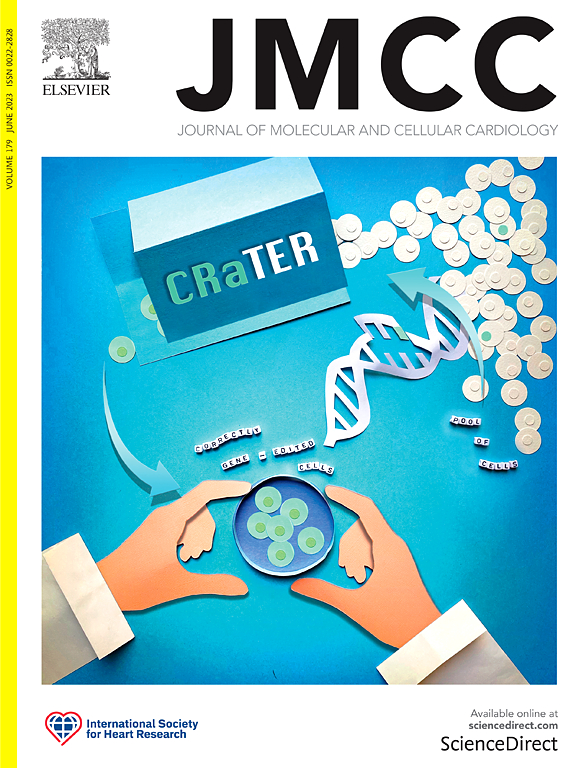Langendorff-heart发现管道证明了细胞外囊泡与β受体阻滞剂使用点击化学功能化的心肌细胞靶向。
IF 4.7
2区 医学
Q1 CARDIAC & CARDIOVASCULAR SYSTEMS
引用次数: 0
摘要
细胞外囊泡(EVs)作为向心肌细胞输送治疗或实验货物的载体被广泛探索。努力提高EV在心脏中的生物利用度,减少它们的脱靶作用,需要能够复制心肌中存在的生理和解剖屏障的筛选方法。此外,发现管道必须控制EV的剂量和时间,并提供一种评估货物特异性进入心肌细胞的方法。在培养细胞或动物上进行的实验通常不符合这些标准。在这里,我们提出了一个朗根多夫心脏发现管道,结合了体内和体外方法的优势。langendorff模式灌注使跳动的心脏受控地暴露于再循环的ev中。灌注后,心肌细胞可以被酶分离用于分析,如成像。我们测试了这一发现管道,使用点击化学方法将β受体阻滞剂(阿替洛尔、美托洛尔)功能化电动汽车,并结合荧光蛋白NeonGreen2来跟踪电动汽车货物的命运。使用β受体阻滞剂修饰的ev进行langendorff处理后,心肌细胞(包括其核区域)的荧光增加,但仅当这些ev含有NeonGreen2时,这表明荧光货物是信号来源。通过参考野生型EV或呈现myomaker或myomixer蛋白的EV获得的显著较低的信号,证实了β受体阻滞剂的优越结合效率,这些基序适度地增加了小鼠心脏EV摄取。我们的研究结果表明,利用β受体结合物修饰的ev成功靶向心肌细胞。我们建议将langendorff灌注心脏作为中间步骤,嵌套在体外表征和动物试验之间,以寻求改进的心脏EV设计。本文章由计算机程序翻译,如有差异,请以英文原文为准。

A Langendorff-heart discovery pipeline demonstrates cardiomyocyte targeting by extracellular vesicles functionalized with beta-blockers using click-chemistry
Extracellular vesicles (EVs) are widely explored as vehicles for delivering therapeutic or experimental cargo to cardiomyocytes. Efforts to improve EV bioavailability in the heart, and reduce their off-target actions, require screening methods that can replicate the physiological and anatomical barriers present in the myocardium. Additionally, discovery pipelines must exercise control over EV dosage and timing, and provide a means of assessing cargo incorporation into cardiomyocytes specifically. These criteria are not generally met by experiments on cultured cells or animals. Here, we present a Langendorff-heart discovery pipeline that combines the strengths of in vivo and in vitro approaches. Langendorff-mode perfusion enables controlled exposure of beating hearts to re-circulated EVs. Following perfusion, cardiomyocytes can be isolated enzymatically for analysis, such as imaging. We tested this discovery pipeline by functionalizing EVs with beta-blockers (atenolol, metoprolol) using click-chemistry and incorporating the fluorescent protein NeonGreen2 to track the fate of EV cargo. Fluorescence in cardiomyocytes, including their nuclear regions, increased after Langendorff-treatment with beta-blocker decorated EVs, but only if these contained NeonGreen2, implicating the fluorescent cargo as the source of signal. Superior binding efficacy of beta-blockers was confirmed by referencing to the substantially lower signals obtained using wild-type EVs or EVs presenting myomaker or myomixer proteins, motifs that modestly enrich cardiac EV uptake in mice. Our findings demonstrate successful cardiomyocyte targeting using EVs decorated with beta-receptor binders. We propose the Langendorff-perfused heart as an intermediate step - nested between in vitro characterisation and animal testing - in discovery pipelines for seeking improved cardiac-specific EV designs.
求助全文
通过发布文献求助,成功后即可免费获取论文全文。
去求助
来源期刊
CiteScore
10.70
自引率
0.00%
发文量
171
审稿时长
42 days
期刊介绍:
The Journal of Molecular and Cellular Cardiology publishes work advancing knowledge of the mechanisms responsible for both normal and diseased cardiovascular function. To this end papers are published in all relevant areas. These include (but are not limited to): structural biology; genetics; proteomics; morphology; stem cells; molecular biology; metabolism; biophysics; bioengineering; computational modeling and systems analysis; electrophysiology; pharmacology and physiology. Papers are encouraged with both basic and translational approaches. The journal is directed not only to basic scientists but also to clinical cardiologists who wish to follow the rapidly advancing frontiers of basic knowledge of the heart and circulation.

 求助内容:
求助内容: 应助结果提醒方式:
应助结果提醒方式:


